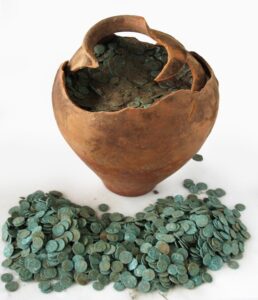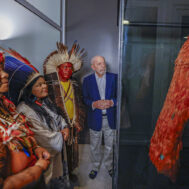Indiana Jones and the Dial of Destiny has been a major disappointment at the box office. According to some analysts, its gross might not even exceed that of the individual movies of the original 1980’s trilogy without an adjustment for inflation. It has been suggested that today’s audiences can no longer identify with Indie’s swashbuckling archaeologist, who acquires treasures from other cultures so they can be displayed at a museum. Certainly, repatriation not acquisition appears to be the new default position as far as legacy and social media are concerned. Indeed, based on all that publicity, any collector of archaeological or ethnological material would be forgiven for wondering whether collecting itself will survive the mania to repatriate anything and everything old to where it was supposedly made centuries or even millennia ago.

Leading figures in the “non-aligned” nations whose perspective informed the 1970 UNESCO Convention: Nehru, Nkrumah, Nasser, Sukarno and Tito.
Like many successful narratives, the “send all the old stuff back” one relies on a simple storyline where heroes take on villains to redress a wrong. In the Indiana Jones franchise, the hero, Indie, takes on villains (usually Nazis) in order to save important artifacts for “mankind” which is represented by “museums.” Now, however, it is “museums” and “collectors” that are the “bad guys” with crusading archaeologists and law enforcement portraying “the good guys” who repatriate “stolen property” to its rightful owners. Even Harrison Ford, the actor who brought Indie to life, professes to be “pleased to see the movement now to return these objects to their original cultures.”[2]
So how did this state of affairs come to pass and how can the collecting narrative be reset? Repatriation first became “cool” with the 1970 UNESCO Convention. The 1970 UNESCO Convention was conceived as an “anti-colonialist” response to the illicit removal of cultural artifacts from the developing world. Many such “victim” countries had turned to Communist or Socialist ideology as part of their rejection of the market capitalism of their former European colonial overlords. That ideology is reflected in the extensive laundry list of types of artifacts subject to possible government ownership or control under both UNESCO and the laws of such “victim” nations.

Sen. Bob Dole worked with Sen. Patrick Moynihan to pass the CPIA, helping nations against looting and protecting US trade.

Moynihan and Dole were wary of diplomatic misuse of CPIA and conflict with the NSPA.
The US was initially wary of the Convention and the “statist” values it embraced. Ultimately, however, due to pressure from US archaeologists who depended on governments in the developing world to issue them excavation permits, and a State Department primarily interested in furthering our diplomatic relations, the US ultimately agreed to sign on to the Convention.
Nevertheless, to protect “American values” like “private property rights,” US accession to UNESCO was conditioned on reservations designed to protect its “independent judgment” to determine what types of items should be subject to repatriation as well as to ensure that such actions were not “retroactive.” The Convention is not “self-executing,” so Congress was also careful to ensure that these reservations were also ultimately reflected in the provisions of the Cultural Property Implementation Act (CPIA), the statute that Congress passed to apply the Convention domestically.

Bamiyan, Afghanistan. Light show projecting image of Buddha destroyed by Taliban on cliff. US now has CPIA agreement to return objects to Afghanistan, governed by Taliban. Xinhua.
As time went on, however, expediency prevailed over protecting private property as the State Department and law enforcement saw repatriation as a quid pro quo to encourage foreign governments to cooperate with them on other matters deemed more important. This retreat from American values has received a pass in the media which is more interested in writing moralistic tales about righting wrongs on behalf of “victims” of theft. More often than not, it’s just assumed that these “victims” are equated with national governments in source countries, which are deemed to represent their citizens, even in cases where the government in question is an authoritarian one or an outright dictatorship at war with its own people.
So what can collectors do to reset the narrative? While the days of brazenly acquiring newly found objects in contravention of foreign laws (even ones of authoritarian governments) are over, there still is every reason for collectors to fight the narrative that “all the old stuff should go back.” But how?

Daesh members smashing copies of statues in the Mosul Museum. Screenshot Daesh propaganda video.
First, collectors must do a much better job calling out “fake news” that law enforcement, the State Department, and archaeological advocacy groups have used to help justify, fund, and expand their efforts. Of course, there will always be bad actors, but the real issue for policy makers is the scope of the problem. In that regard, two academics associated with the archaeological lobby recently admitted that long made claims that the illicit antiquities trade is “the world’s third largest, second only to arms and narcotics” are completely unsubstantiated.[3] Less noticed was the fact that Kate Fitz Gibbon, the editor of “Cultural Property News,” expressed these same concerns as far back as 2005.[4]
Even more damaging, and just as wrong, are claims that looted antiquities were the second largest funding source for the hated terror group, the Islamic State.[5] Again, by the time RAND Corporation and others debunked such claims, it was too late.[6] In the interim, draconian import and “anti-money laundering” regulations were enacted in the US, UK and EU based on such false information. And even today, similar “zombie statistics” continue to be repeated in the media in order to justify additional regulation of collectors and the trade.[7]

Man holding a burnt manuscript, IHERI-AB, Timbuktu, 31 January 2013, UNESCOGLAM-Wiki partnership.
Second, collectors should call out knee jerk efforts to repatriate objects as “stolen property” no matter what the circumstances. Critically, concerns about retroactive application of the UNESCO Convention have been sidestepped by treating any artifact “found in the ground” after the passage of a foreign law vesting ownership in the State as “stolen property” under US criminal laws. More often than not, the objects that are being repatriated have been openly displayed for decades or sold multiple times at public auctions. Also, though spun as “saving history,” law enforcement efforts have resulted in removing cultural treasures from the safety of US so they can be sent to war zones in places like Libya and Mali where they could get destroyed. Other artifacts have been sent to the likes of Iran, even though the Mullah’s fundamentalist regime is hostile both to America as well as the country’s magnificent pre-Islamic past.

The Shrewsbury hoard, The Portable Antiquities Scheme, Harriet Louth, 2011-05-31, 18 radiates and 9297 nummi minted between AD 307 and 335, CCA-SA 4.0 International license.
Finally, collectors need to accentuate the positive. Collecting archaeological and ethnological objects helps encourage people to people contacts and the appreciation of other cultures. Moreover, collecting, particularly collecting very common cultural goods like historical coins, helps preserve these artifacts for future generations. Let’s be frank. Museum storehouses both in “Market Countries” and “Source Countries” are chock full of minor artifacts which will never be adequately studied, displayed and may not even be properly conserved.
Collectors should also highlight enlightened programs like the United Kingdom’s Treasure Act and Portable Antiquities Scheme. These programs encourage finders to report their finds so they can be recorded in an on-line database available to anyone interested in objects found there. The Treasure Act also provides museums with a right of first refusal over significant finds, which are then purchased for fair market value. Those not retained (mostly coins) are then returned to the finder, who can sell them to collectors. Not surprisingly, due to British “fair play” we know more about ancient coin circulation in Britain and Wales than anywhere else. If only there were more positive stories like that!
Next Installment: The Life and Times of Antiquities Dealer Leo Patterson
Further Reading:
On Indiana Jones Box Office Flop
Ian Sandwell, Why Indiana Jones and the Dial of Destiny has been a box-office flop, Digital Spy (July 10, 2023)
On Changing Mores in the Antiquities Market
Julie Belcove, Collecting Antiquities Has Never Been So Fraught. Here’s How to Do It the Right Way, Robb Report (August 5, 2023)
Fake News About the Size of the Illicit Antiquities Market
Donna Yates and Neal Brodie, The illicit trade in antiquities is not the world’s third-largest illicit trade: a critical evaluation of a factoid, Cambridge University Press (June 29. 2023)
UK Treasure Act and Portable Antiquities Scheme
Portable Antiquities Scheme Website.
[1] Peter K. Tompa is a semi-retired lawyer who resides in Washington, D.C. He has written extensively about cultural heritage issues, particularly those of interest to the numismatic trade. Peter contributed to Who Owns the Past?” (K. Fitz Gibbon, ed. Rutgers 2005). He formerly served as executive director of the Global Heritage Alliance and now is a member of its board of directors. This article is a public resource for general information and opinion about cultural property issues and is not intended to be a source for legal advice. Any factual patterns discussed may or may not be inspired by real people and events.
[2] Simon Ingram, Did Indiana Jones Help or Hurt Archaeology?, National Geographic (June 23, 2023)
[3] See Morag M. Kersel, Challenging a 50-Year-Old Factoid About the Illegal Antiquities Trade, Hyperallergic (July 27, 2023)
[4] Kate Fitz Gibbon, Editor’s Note: The Illicit Trade—Fact or Fiction? In Who Owns the Past 179 (Rutgers 2005).
[5] Jason Felch, Dante’s Inference: The Known Unknowns of ISIS and Antiquities Looting, Chasing Aphrodite Blog (November 18, 2014) [6] Kate Fitz Gibbon, RAND Corp Report Demolishes Assumptions on Antiquities and Terror, Cultural Property News (July 30, 2020)
[7] How Officialdom’s Zombie Statistics and Bogus Data Continue to Plague the Art Market and Antiquities, Antiquities Dealers’ Association (April 28, 2023)
 Plait kangaroo hide bullwhip and hat. Photo by Gary Stewart (Gary2880), 15 March 2008, CCA 3.0 Unported license.
Plait kangaroo hide bullwhip and hat. Photo by Gary Stewart (Gary2880), 15 March 2008, CCA 3.0 Unported license. 

